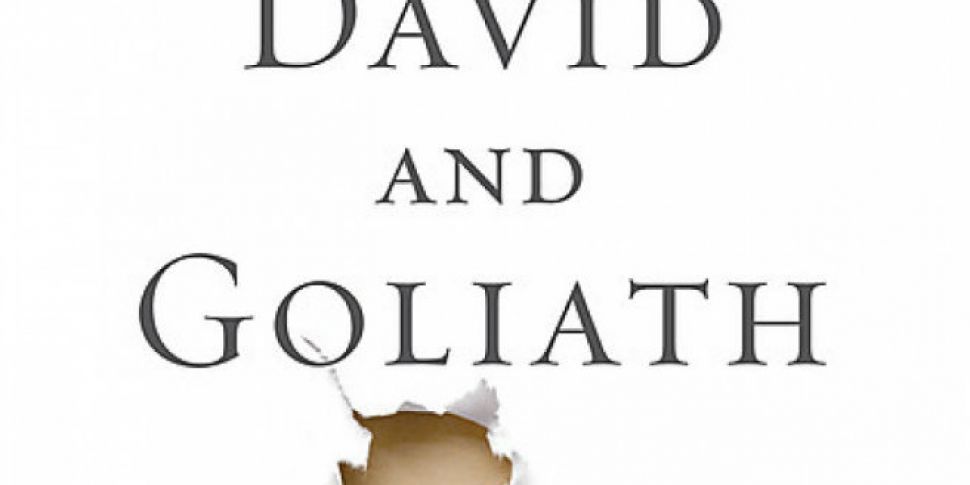Listen back to Alan Jordan and Ian Guider discuss the book on Newstalk Breakfast via the player above
In The Tipping Point (2000) Malcolm Gladwell introduced us to the turning points at the creation of a trend. In Blink (2005) he told us how we act on instinct without thinking and Outliers (2008) he said you had to work hard to achieve success - about 10,000 hours of practising should do it. In David & Goliath (2013) everything is not as it seems. Advantage can sometimes be a disadvantage and vice versa. Gladwell said that he wanted to write this book because,
“I felt that we continue to make all kinds of mistakes, whether it’s in our foreign policy or our educational policy, based on a misunderstanding of what works; of what’s advantageous. I also thought it was time to write a more sophisticated account of where power and authority really come from and that in every crisis there is an incredible opportunity for growth.”
Gladwell offers insights about the “legitimacy of authority”, discussing policing in Brownsville New York, the flawed military tactics deployed in Northern Ireland and the “Three Strikes and You’re Out” judicial system of California. Couple that with a polemic on the flaws within our education system, a journey through the Deep South and the civil rights protests of the early 60s and you’ve got enough to get a debate going.
Through these pieces he weaves and tells the stories of the people who were there who made the difference “the misfits, the underdogs who battled the Giants”.
Gladwell starts his discourse with the David and Goliath story and acknowledges that the former Israeli minister of defence Moshe Dayan - the architect of Israel’s victory in the 1967 Six-Day War - also wrote an essay on the story of David and Goliath. According to Dayan, “David fought Goliath not with inferior but (on the contrary) with superior weaponry; and his greatness consisted not in his being willing to go out into battle against someone far stronger than he was. But in his knowing how to exploit a weapon by which a feeble person could seize the advantage and become stronger.”
Education
So it is on this theme of advantage and all is not what it seems that leads him into education and the surprising statistic that “77% of Americans think that it makes more sense to use taxpayer money to lower class sizes than to raise teachers’ salaries.”
Gladwell argues that “there isn’t a single profession in the world that has increased its numbers over the past two decades by as much or as quickly or at such expense as teaching has. That is precisely what many industrialized countries have done in recent years, it costs so much to hire extra teachers and build them classrooms that there is precious little money left over to pay teachers. As a result, the salaries of teachers, relative to other professions, have steadily fallen over the past fifty years”
He argues, “Humans are more influenced in decision-making by innate emotions than rational thought” (as the many books we have covered on cognitive biases and the recent emerging discoveries in the field of neuroscience). As Frank Carson says it’s the way he tells them.
The fixation around the world that smaller class sizes = better education and better students is he says not proven. Class-size reduction “steals away the peers that struggling students learn from. They are awkward and self-conscious and anxious about seeming too smart. Getting them to engage, to move beyond simple question-and-answer sessions with their teacher, can be “like pulling teeth.”
Why were smaller classes wanted he asks? “One answer lies in the politics of the educational world—in the power of teachers and their unions, and in the peculiarities of the way schools are funded. Because the people and countries that are wealthy enough to pay for things like really small classes have a hard time understanding that the things their wealth can buy might not always make them better off.”
Civil Rights
Birmingham’s Alabama other nickname was Bombingham. “In Birmingham,” Diane McWhorter writes in Carry Me Home, "The surest way to stop a crime wave was to go out and shoot a few suspects." The story behind the famous photograph of the civil rights movement — a black teenager (Walter Gasden) being attacked by a police dog in Birmingham, Ala., in 1963.

Gladwell demonstrates that the weak are not always what they seem. In fact, as he learned, the 15-year-old in the picture was a spectator, not a demonstrator. Closer scrutiny of the photograph, showed the police trying to hold the dogs back. But that’s only the tail of the story: Civil rights organiser Wyatt Walker was looking for publicity-worthy confrontations, and Gladwell explains how he tricked the local authorities into confusing bystanders with demonstrators to heighten the sense of alarm.
Northern Ireland & The Troubles
In those years, when the world was exploding in violence, Gladwell argues that everyone read Nathan Leites and Charles Wolf, Rebellion and Authority.
He says,“Itbecame the blueprint for the war in Vietnam, and for how police departments dealt with civil unrest, and for how governments coped with terrorism. Its conclusion was simple: Fundamental to our analysis is the assumption that the population, as individuals or groups, behaves “rationally,” that it calculates costs and benefits to the extent that they can be related to different courses of action, and makes choices accordingly… getting insurgents to behave is fundamentally a math problem. If there are riots in the streets of Belfast, it’s because the costs to rioters of burning houses and smashing windows aren’t high enough. And when Leites and Wolf said that “influencing popular behaviour requires neither sympathy nor mysticism,” what they meant was that nothing mattered but that calculation. If you were in a position of power, you didn’t have to worry about how lawbreakers felt about what you were doing. You just had to be tough enough to make them think twice.” QED for all the problems in N.I. then?
He goes on, “When people in authority want the rest of us to behave, it matters—first and foremost—how they behave. This is called the “principle of legitimacy,” and legitimacy is based on three things. First of all, the people who are asked to obey authority have to feel like they have a voice—that if they speak up, they will be heard. Second, the law has to be predictable. There has to be a reasonable expectation that the rules tomorrow are going to be roughly the same as the rules today. And third, the authority has to be fair. It can’t treat one group differently from another”
Three strikes and you are out
The theme of authority runs throughout the book and Gladwell deals with the introduction of the “Three strikes and you are out” legislation after the pivotal murder of Michael Reynolds daughter in 1993. Twenty years of debate have perhaps finally come to a conclusion with a repeal of the legislation in 2012.
Gladwell argues that the “Inverted U Curve" - basically the Law of Diminishing Returns applies. “You and I are sensitive to increased punishment, because you and I are people with a stake in society. But criminals aren’t. Where no viable alternative to crime exists, there clearly is little point in dwelling on the potentially negative consequences of offending. It should come as no surprise, then, to learn that the offenders usually preferred to ignore the possible risk and concentrate instead on the anticipated reward”
He goes on, “What if the relationship between punishment and crime was also an inverted U? In other words, what if—past a certain point—cracking down on crime stopped having any effect on criminals and maybe even started to make crime worse? But remember, the logic of the inverted-U curve is that the same strategies that work really well at first stop working past a certain point, and that’s exactly what many criminologists argue happens with punishment.”
Conclusion
When it comes down to it there are two types of people in this world. People who like Malcolm Gladwell and those that don’t and in this book both sets of supporters will find what they are looking for. His research is perhaps not deep enough, he cherry picks his findings. He is a journalist after all not a scientist. As Gladwell says of himself “my books are gateway drugs – they lead you to the hard stuff.”
While the book focuses on the underdog and the misfit I think the real value is what it asks us about behaviour. If you really want to Kill Giants check out Stephen Kenny’s book.
So what’s in this for business?
Business
When you get down to it, this book is all about behaviour and absolutely everyone is concerned about behaviour.
Psychologists want to understand it.
Marketers want to predict it
Innovators want to unleash it
HR wants to influence it
Sales are trained to watch for it
And Government wants to control it
Are your rules and policies really going to make your people be authentic about your product or service?
By having your sales force metriced up to the wazoo will you really understand your customer in a way that they want to be understood?
Because you’ve just had the all hands training day will you see a change in the commitment from the front line troops that you hoped for?
“Influencing behaviour requires what to happen in your organisation?”
David and Goliath tells us that we are still not sure of the answer.
If you have any thoughts on the book or any of the points above, please comment below.
Alan Jordan is the sales director with BookBuzz









